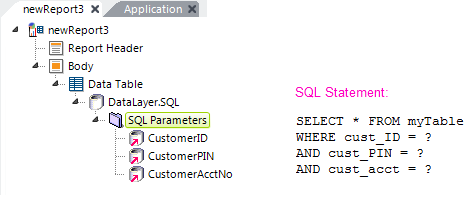DataLayer.SQL - Using SQL Parameters
The SQL Parameters and SQL Parameter elements can be used to include tokenized parameters, if you prefer not to embed tokens directly into the SQL statement. This approach also allows you to enforce a data type for the parameter value and also offers protection against SQL Injection attacks.
To use parameters, you write your SQL statement using "placeholder" notation. The exact syntax depends on your database and the Connection element you're using. For example, if you're using Connection.SQLServer, you use this notation:
SELECT * FROM Customers WHERE State=@state AND City=@city
and the ID attribute of each SQL Parameter element must match a placeholder name. So, in the example, the value of an element with an ID of state will replace the @state placeholder at runtime.
Similarly, if you're using Connection.Oracle, you use this notation:
SELECT * FROM Customers WHERE State=:state AND City=:city
and, as before, the ID attribute of each SQL Parameter element must match a placeholder name.
If you're using Connection.OLEDB, you use this notation:
SELECT * FROM Customers WHERE State=? AND City=?
Unlike the previous examples, these are positional parameters so, at runtime, placeholders in the statement will be replaced, starting with the first placeholder, by the values specified in the SQL Parameter elements, based on the elements' top-to-bottom order in the definition. The element IDs are ignored.

The example above illustrates the relationship, in this scenario, between SQL Parameter element order and placeholders in the statement.
![]() SQL Parameters will not work when using Connection.ODBC.
Consult your database documentation for its specific placeholder syntax.
SQL Parameters will not work when using Connection.ODBC.
Consult your database documentation for its specific placeholder syntax.